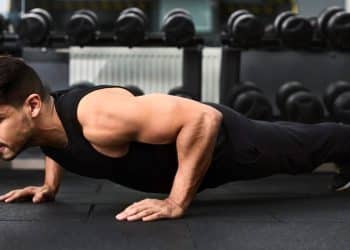BOSU balls have been around for almost 20 years, and they’re still in use. This means only one thing – they really do work! The fitness industry is often affected by trends, and new training tools come and go quite quickly.
The fact that BOSU balls are still in use after two decades means they are not just a fad, and using one may help you reach your training goals faster.
But what IS a BOSU ball, and how do they work? Let’s investigate!
BOSU Ball Training 101
In simple terms, a BOSU ball is an inflatable hemisphere or dome with a hard plastic base. This means it can be used with either side facing up. That’s actually how this particular exercise tool got its name – BOSU stands for Both Sides Up, or Both Sides Utilized.
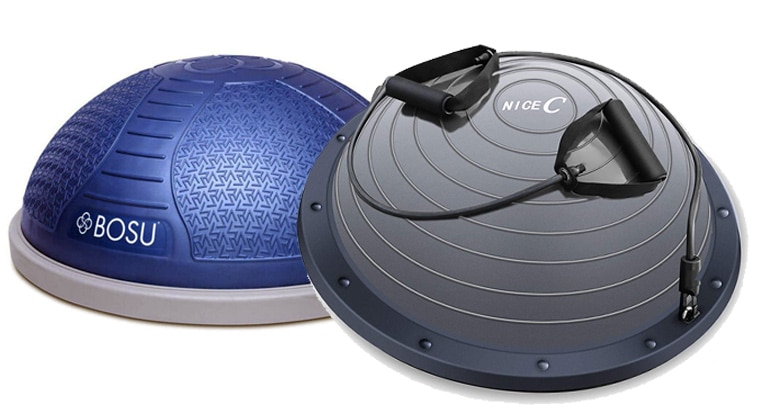
BOSU balls are inherently unstable, and using one will challenge your balance. As they wobble, you’ll need to work harder to maintain stability, and this will affect muscles like your shoulder rotator cuff, core, and hip and knee stabilizers, as well as your nervous system.
Level Up Your Fitness: Join our 💪 strong community in Fitness Volt Newsletter. Get daily inspiration, expert-backed workouts, nutrition tips, the latest in strength sports, and the support you need to reach your goals. Subscribe for free!
In theory, balance improvements gained from using a BOSU should translate to better balance out in the “real” world. For example, if you do squats and lunges using a BOSU, you can improve your balance for activities like skiing or paddleboarding.
In addition, this wobbling also increases core activation. You’ll need to brace your abs harder to keep your torso and lumbar spine properly aligned, meaning most BOSU ball exercises are also good core exercises too.
Studies also suggest that training with a BOSU ball can help increase strength and power as well as balance, and are useful for exercisers of all ages (1). BOSU balls are also helpful for speeding up recovery after injury. Nerves called proprioceptors are often damaged along with muscles and ligaments, and BOSU ball training may help restore lost function (2).
You can also use BOSU ball training to reveal and fix left-to-right strength imbalances. If you push harder with one leg or one arm, you’ll soon spot the problem and, once you are aware of it, you can focus on correcting it.
On the downside, training on a BOSU ball means you won’t be able to lift as much weight as you can when sitting or standing on something more stable. You may also find that smaller stabilizer muscles fail before the muscle you are training. This means that BOSU ball exercises are not the best choice for building muscle.
That said, something like a few sets of light BOSU ball squats will help fire up your nervous system and stabilizer muscles before moving onto heavy barbell squats, increasing your subsequent performance. A set or two of BOSU ball push-ups will have a similar effect before bench presses.
The TEN Best BOSU Ball Exercises
Here are ten of the best BOSU ball exercises to try. Bear in mind that these exercises are more challenging than their more stable counterparts, so start light and focus on your balance and form before increasing the resistance.
Also, make sure you spend a few minutes warming up before your workout to get your body and mind ready for what you are about to do. Some light cardio and dynamic stretches are a good place to start, and a few reps of your chosen exercise on a stable surface will probably help too.
Finally, because you’re going to wobble more than usual, make sure you have a clear area around you so that if you lose your balance, you won’t hurt yourself or anyone near you.
1. BOSU Ball Push-ups
The push-up is probably the most widely performed exercise on the planet. Kick your workout up a notch by doing it with your hands on a BOSU ball.
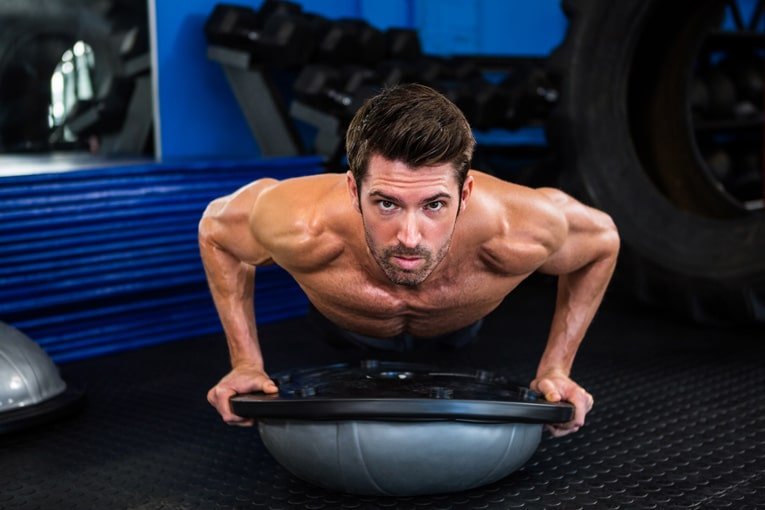
Muscles Worked:
Pectoralis major – the muscles on the front of your chest. Known as the pecs for short, this muscle group is responsible for horizontal flexion of your shoulder joint.
Anterior deltoid – your front shoulder muscles, the anterior delts are responsible for flexion and horizontal flexion of the shoulder joint.
Triceps brachii – located on the back of your upper arm, the triceps extend your elbows and also extend your shoulder joint.
Rotator cuff – the collective term for the muscles that stabilize and control your shoulder joint, namely the supraspinatus, infraspinatus, subscapularis, and teres minor.
Core – the collective term for the muscles that make up your midsection, including your rectus abdominis, obliques, and erector spinae.
How to do it:
- Place your BOSU ball on the floor, curved side down. Squat down and place your hands on the edge of the platform.
- Walk your feet back until your legs are straight. Brace your abs and pull your shoulders down and back for stability.
- Bend your arms and lower your chest down to the BOSU ball.
- Extend your arms and push yourself back up again.
- Do not let your hips lift or drop out of alignment. Keep your shoulders level.
- Make this exercise easier by bending your legs and placing your knees on the floor, or harder by raising your feet on a bench or step.
2. BOSU Ball Squats
BOSU ball squats are a useful exercise for developing lower body balance and strength. Because of the risk of falling over, you should only do this exercise with dumbbells, and not a barbell.
Muscles Worked:
Quadriceps – located on the front of your thighs, the quads are responsible for extending your knees.
Hamstrings – your primary knee flexors, the hamstrings also extend your hip.
Gluteus maximum – your glutes are the biggest muscle in your body, and their primary role is the extension of the hip joint.
Abductors and adductors – the collective term for the muscles on the outside and inside of your hips, these muscle groups stabilize your hips and knees and are especially active during this exercise.
Core – the muscles of your midsection, and responsible for stabilizing your spine.
How to do it:
- With the curved side of the BOSU ball facing down, stand on it with your feet between shoulder to hip-width apart. Your weight should be distributed evenly from left to right, and also between your heels and the balls of your feet.
- Push your hips back, bend your knees, and squat down as far as you can without rounding your lower back.
- Extend your arms in front of you if you need help balancing.
- Stand back up and repeat.
- Make this exercise harder by holding dumbbells in your hands or a kettlebell in front of your chest.
- You can also do this exercise with the BOSU ball curved side up. This makes it much harder.
3. BOSU Ball Crunches
A lot of exercisers find crunches to be pretty easy. After all, done on the floor, the range of motion is very small, and you’ve only got to lift your head and shoulders a few inches. BOSU ball crunches are MUCH more challenging.
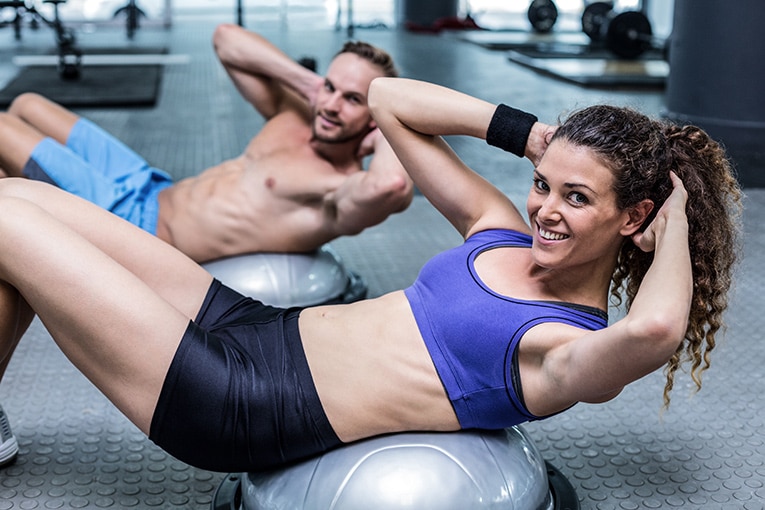
Muscles worked:
Rectus abdominis – located on the front of your abdomen, this muscle is responsible for the flexion of your spine and is basically your “six-pack” muscle. Although, you’ll only be able to see it if you are lean enough!
How to do it:
- With your BOSU ball on the floor, curved side up, sit on the edge of the ball with your legs bent and feet flat on the floor. Place your hands on your temples or across your chest as preferred.
- Lean back over the ball so that the rounded surface fits into the natural curve of your lower back. Lean back until your abs are slightly stretched.
- Contract your abs and curl your head and shoulders up toward your hips. Make a C-shape with your spine.
- Lie back down and repeat.
- Exhale forcefully as you sit up to make this exercise more effective.
4. BOSU Ball Lunges
Lunges work the same muscles as squats, but one leg at a time. This makes them especially useful for improving your mobility and balance. This goes double when you do your lunges using a BOSU ball.
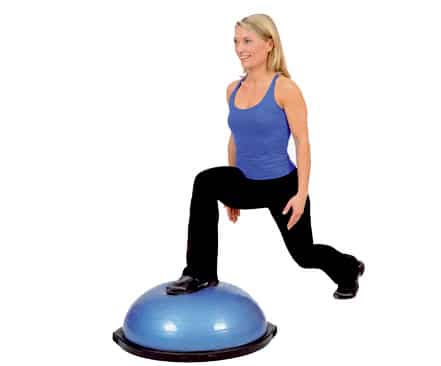
Muscles worked:
Quadriceps – located on the front of your thighs, the quads are responsible for extending your knees.
Hamstrings – your primary knee flexors, the hamstrings also extend your hip.
Gluteus maximus – your glutes are the biggest muscle in your body, and their main role is extension of the hip joint.
Abductors and adductors – the collective term for the muscles on the outside and inside of your hips respectively, these muscle groups stabilize your hips and knees and are especially active during this exercise.
Core – the muscles of your midsection, and responsible for stabilizing your spine.
Level Up Your Fitness: Join our 💪 strong community in Fitness Volt Newsletter. Get daily inspiration, expert-backed workouts, nutrition tips, the latest in strength sports, and the support you need to reach your goals. Subscribe for free!
How to do it:
- Place your BOSU ball on the floor, curved side uppermost. Stand with your feet together about 2-3 feet behind the ball.
- Take a large step forward and place your leading foot on the top of the ball.
- Bend your legs and lower your rear knee down to within a few inches of the floor.
- Work hard to maintain your balance and stop your knee falling in or outward.
- Push off your front leg and return to the starting position.
- Do an identical lunge on the other side and continue alternating legs for the duration of your set.
- Make this exercise harder by holding a dumbbell in each hand.
5. BOSU Ball Push-up Planks
This exercise works your abs and your shoulder stabilizers. If regular planks no longer present much of a challenge, you should find this exercise much more rewarding.
Muscles used:
Core – the collective term for the muscles that make up your midsection, including your rectus abdominis, obliques, and erector spinae.
- Place your BOSU ball on the floor, curved side down. Put your hands on the top and walk your feet back and into the push-up position. Brace your abs and pull your shoulders down and back for stability.
- Brace your abs as hard as you can and keep your body straight for the duration of your set. Do not hold your breath.
- Make this exercise harder by lifting one foot off the floor or, alternatively, placing your feet on a second BOSU ball.
- You can also do this exercise with the BOSU ball curved side up and resting on your forearms, although this is not as challenging.
6. BOSU Mountain Climbers
If BOSU ball planks are too easy for you, try this dynamic variation. With much more movement to contend with, this exercise will challenge your core and your balance at the same time.
Muscles used:
Core – the collective term for the muscles that make up your midsection, including your rectus abdominis, obliques, and erector spinae.
How to do it:
- Place your BOSU ball on the floor, curved side down. Squat down and place your hands on the top, shoulder-width apart. Walk your feet back and into the push-up position. Brace your abs.
- Bend one leg and pull your knee up and into your elbow. Keep your abs braced and work hard to keep your shoulders and hips level.
- Extend your leg and repeat on the opposite side.
- Increase oblique (waist) muscle activation by taking your knee under your body to the opposite elbow.
7. BOSU Ball Glute Bridge
The glute bridge, also known as the hip thrust, is a hugely popular exercise. As the name suggests, this exercise primarily works your glutes. Doing it with your feet on a BOSU ball adds an extra dimension to what is already a very effective exercise. Unlike a lot of glute exercises, this move is easy on your lower back.
Muscles worked:
Gluteus maximus – your glutes are the biggest muscle in your body, and their main role is extension of the hip joint.
Hamstrings – your primary knee flexors, the hamstrings also extend your hip.
How to do it:
- Place your BOSU ball on the floor, curved side up. Lie on the floor with your legs bent and feet on the top of the ball. Rest your arms on the floor by your sides.
- Push your feet into the ball and lift your hips up until your knees, hips, and shoulders form a straight line.
- Lower your butt back down to the floor and repeat.
- Make this exercise harder by holding a weight across your hips or using just one leg at a time.
8. BOSU Ball Boat Pose
Boat pose is an abs and yoga exercise that you can take to a whole new level by doing it on a BOSU ball. Think of this as a plank but facing the sky instead of with your face to the floor.
Muscles worked:
Core – the collective term for the muscles that make up your midsection, including your rectus abdominis, obliques, and erector spinae.
How to do it:
- Place your BOSU ball on the floor, curved side up. Sit on the ball with your feet on the floor. Lean back slightly.
- Using your upper body and arms for balance, lift your legs up until your shins are roughly parallel to the floor.
- Hold this position, but not your breath, for as long as your abs or balance holds out!
9. BOSU Ball Plyometric Push-ups
If you’ve mastered regular push-ups and BOSU ball push-ups, you’re probably ready for a new challenge. This exercise adds a new element to what is already a very demanding upper body exercise.
Muscles worked:
Pectoralis major – the muscles on the front of your chest. Known as the pecs for short, this muscle group is responsible for horizontal flexion of your shoulder joint.
Anterior deltoid – your front shoulder muscles, your anterior delts are responsible for flexion and horizontal flexion of the shoulder joint.
Triceps brachii – located on the back of your upper arm, the triceps extend your elbows and also extend your shoulder joint.
Rotator cuff – the collective term for the muscles that stabilize and control your shoulder joint, namely the supraspinatus, infraspinatus, subscapularis, and teres minor.
Core – the collective term for the muscles that make up your midsection, including your rectus abdominis, obliques, and erector spinae.
How to do it:
- Place your BOSU ball on the floor, curved side down. Squat down and grab the sides of the platform. Walk your feet out and back into the push-up position. Brace your abs.
- Bend your arms and lower your chest down to the top of the ball. Next, extend your arms and push yourself up as fast as you can. Pull the BOSU ball up and off the floor.
- Land on slightly bent arms and repeat.
10. BOSU Ball Thrusters
Thrusters are a full-body exercise that’s popular with CrossFitters. It’s an excellent total body conditioner that’s perfect for those times when you want a good workout but only have a few minutes to spare. Doing it on a BOSU ball makes this already great exercise even more effective.
Muscles worked:
Quadriceps – located on the front of your thighs, the quads are responsible for extending your knees.
Hamstrings – your primary knee flexors, the hamstrings also extend your hip.
Gluteus maximus – your glutes are the biggest muscle in your body, and their main role is extension of the hip joint.
Abductors and adductors – the collective term for the muscles on the outside and inside of your hips respectively, these muscle groups stabilize your hips and knees and are especially active during this exercise.
Core – the muscles of your midsection, and responsible for stabilizing your spine.
Deltoids – the correct name for the muscles of your shoulders. This exercise involves all three deltoid heads but emphasizes the anterior or front head.
Triceps – the muscle located on the back of your upper arm, which is responsible for extending your elbow.
How to do it:
- Place your BOSU ball on the floor with the curved side facing downward. Stand on the BOSU ball with your feet roughly hip to shoulder-width apart. Hold a medicine ball in front of your chest.
- Bend your legs and squat down until your thighs are roughly parallel to the floor.
- Stand back up and then press the medicine ball up and overhead.
- Lower the ball back to your chest and repeat.
- You can also do this exercise with a pair of dumbbells or kettlebells.
BOSU Ball Training Tips
Get the most from these BOSU ball exercises with these handy training tips!
Always brace your abs – brace your abs before you sit, lie, or stand on your BOSU ball. You’ll find it easier to balance if you do. To brace your abs, tense your midsection like you’re expecting to get punched in the stomach. Next, inhale down and into your belly. You should feel your abdomen swell and stiffen. Breathe shallowly to maintain intra-abdominal pressure and keep your spine supported.
Fix your eyes on an immovable object – if you find it hard to balance on your BOSU ball, keep your eyes fixed on something that doesn’t move, and that’s about head-height. This will give you a point of reference that should help you to maintain your balance more easily. Conversely, if you want to make an exercise harder, try closing your eyes.
Reduce your base of support to make any BOSU ball exercise harder – the closer your hands or feet are to the middle of the ball, the harder your chosen exercise will be. In contrast, if you move your hands or feet outward, you should find it easier to balance, making your workout easier. Move your hands and feet in or out accordingly.
The more inflated your BOSU ball is, the harder your workout will be – it’s easier to balance on a BOSU when it’s got less air in it. If you are a beginner, don’t inflate your BOSU ball too much until your balance has started to improve. If you find an exercise too tricky, letting a little bit of air out of your BOSU ball often helps.
Wear flat-soled shoes for better balance – running shoes, with their raised heels and shock-absorbing soles, make balancing on a BOSU ball harder. Flat-soled minimalist shoes make balancing easier. Bare feet are NOT recommended because, if your feet get sweaty, you may slip, especially on the curved side.
Wrapping Up
Balance is an essential component of fitness. Without balance, you won’t be able to perform at your best. Balance declines with lack of use, and also with age. If you play sports, or just want to live a long and independent life, you need to improve and maintain your balance.
One way to do that is to incorporate some BOSU ball exercises into your workouts.
You don’t need to go all BOSU, all the time. In fact, if muscle building is your main goal, that’s the LAST thing you should do. But, even if you are a bodybuilder, some BOSU ball exercises could do you a lot of good.
References:
- PubMed: Effects of Strength Training Using Unstable Surfaces on Strength, Power, and Balance Performance Across the Lifespan: A Systematic Review and Meta-analysis https://www.ncbi.nlm.nih.gov/pmc/articles/PMC4656700/
- PubMed: Instability Resistance Training for Health and Performance https://www.ncbi.nlm.nih.gov/pmc/articles/PMC5388079/



